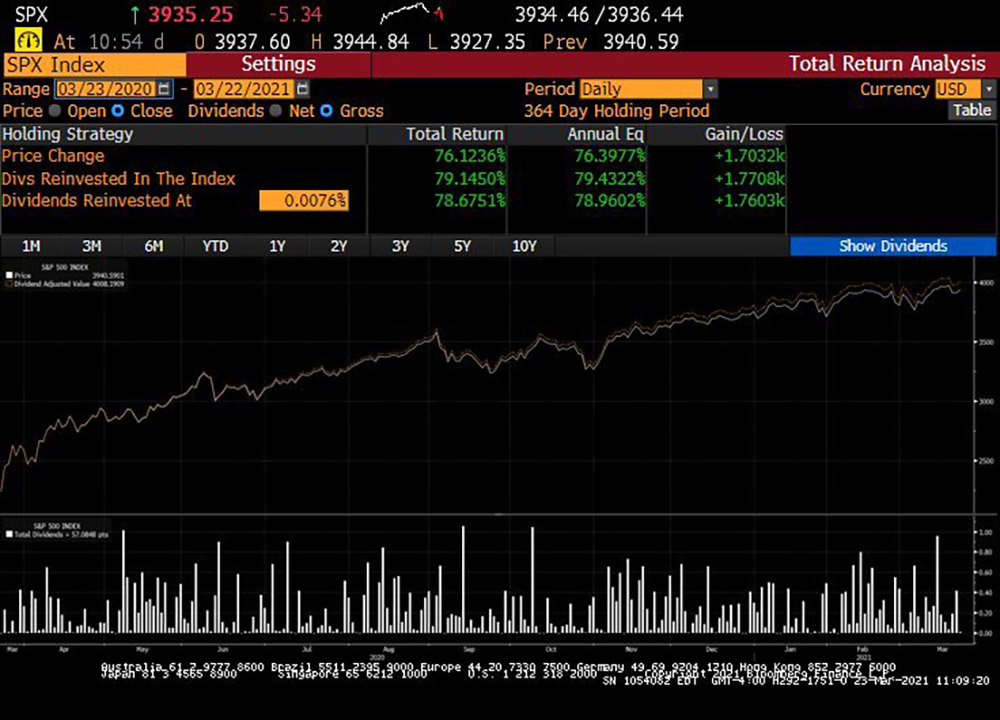一年前的今天,美国股市在短短24个交易日内下跌了34%,有史以来的最快暴跌也是在这段时间里发生的,最终在2020年3月23日股市触底。
不过在此之后,美股的反弹趋势也是惊人的,甚至是历史罕见的。截至3月22日收盘,标普500指数(S&P 500)已经上涨了76%,包含了大量科技股的纳斯达克综指(Nasdaq Composite)更是上涨了95%,道指(Dow)也上涨了76%。(不过3月23日美股市场出现了大跌,以上三个指数各自下跌了0.76%以上。)

LPL金融公司(LPL Financial)于3月22日发布的一篇研究报告指出,这一年来,美股的涨幅不仅惊人,而且这也是历史上从熊市反弹最强势的一年(甚至超过了2009年68.6%的反弹幅度)。
这一年是美国股民丰收的一年,但接下来,美股会向何处去呢?
继续“长牛”的理由
独立顾问联盟公司(Independent Advisor Alliance)的首席投资官克里斯·扎卡雷利等专家对《财富》杂志表示:“之前的增长速度是很难复制的,所以我们对2021年的预期已经有所降低。”
不过扎卡雷利也指出,他认为股市仍然有很多利好因素,“首先是财政刺激,其次,美联储(Federal Reserve)出台了大量货币宽松政策,并且放言接下来几年,短期利率都将维持在低水平。所以我们没有看到任何会影响牛市的迹象。”
瑞银全球财富管理部门(UBS Global Wealth Management)的首席投资官马克·海福乐也在3月23日的一篇文章中称:“虽然股市一直处于牛市,而且疫情还没有结束,但我们认为,风险资产仍然有进一步上涨的理由。”
另外,从历史数据看,在一个新牛市的第二年,股市的情况通常还是比较乐观的。LPL公司的报告还指出,自第二次世界大战以来,“有6个熊市的大盘至少跌了30%,而在每一次熊市之后的第一个牛市年里,标普500指数都会稳步上涨,第二年股市还会延续这种涨势,平均涨幅可达16.9%。”
不过,LPL的这份报告也指出,这种增长并不一定是直线上升。在新牛市的第二年,出现回调也是正常现象,平均回调幅度可达10.2%左右。
目前,有些投资者仍然担心通胀率有可能上升,美联储的货币政策可能突然转向,或者税收政策出现重大调整。与此同时,很多投资者开始关注循环交易,他们的目光已经离开了那些在本轮牛市中反弹最强势的科技股和成长型股票,而是投向了价值股和周期性股票。
独立顾问联盟公司的首席投资官扎卡雷利说:“总之,我们并不认为今年的股市走向是一条直线。但我们也并非觉得股市估值过高了,该到了崩盘或者熊市的时候了。我们认为这里还有一些投资的空间。”(财富中文网)
译者:朴成奎
一年前的今天,美国股市在短短24个交易日内下跌了34%,有史以来的最快暴跌也是在这段时间里发生的,最终在2020年3月23日股市触底。
不过在此之后,美股的反弹趋势也是惊人的,甚至是历史罕见的。截至3月22日收盘,标普500指数(S&P 500)已经上涨了76%,包含了大量科技股的纳斯达克综指(Nasdaq Composite)更是上涨了95%,道指(Dow)也上涨了76%。(不过3月23日美股市场出现了大跌,以上三个指数各自下跌了0.76%以上。)
LPL金融公司(LPL Financial)于3月22日发布的一篇研究报告指出,这一年来,美股的涨幅不仅惊人,而且这也是历史上从熊市反弹最强势的一年(甚至超过了2009年68.6%的反弹幅度)。
这一年是美国股民丰收的一年,但接下来,美股会向何处去呢?
继续“长牛”的理由
独立顾问联盟公司(Independent Advisor Alliance)的首席投资官克里斯·扎卡雷利等专家对《财富》杂志表示:“之前的增长速度是很难复制的,所以我们对2021年的预期已经有所降低。”
不过扎卡雷利也指出,他认为股市仍然有很多利好因素,“首先是财政刺激,其次,美联储(Federal Reserve)出台了大量货币宽松政策,并且放言接下来几年,短期利率都将维持在低水平。所以我们没有看到任何会影响牛市的迹象。”
瑞银全球财富管理部门(UBS Global Wealth Management)的首席投资官马克·海福乐也在3月23日的一篇文章中称:“虽然股市一直处于牛市,而且疫情还没有结束,但我们认为,风险资产仍然有进一步上涨的理由。”
另外,从历史数据看,在一个新牛市的第二年,股市的情况通常还是比较乐观的。LPL公司的报告还指出,自第二次世界大战以来,“有6个熊市的大盘至少跌了30%,而在每一次熊市之后的第一个牛市年里,标普500指数都会稳步上涨,第二年股市还会延续这种涨势,平均涨幅可达16.9%。”
不过,LPL的这份报告也指出,这种增长并不一定是直线上升。在新牛市的第二年,出现回调也是正常现象,平均回调幅度可达10.2%左右。
目前,有些投资者仍然担心通胀率有可能上升,美联储的货币政策可能突然转向,或者税收政策出现重大调整。与此同时,很多投资者开始关注循环交易,他们的目光已经离开了那些在本轮牛市中反弹最强势的科技股和成长型股票,而是投向了价值股和周期性股票。
独立顾问联盟公司的首席投资官扎卡雷利说:“总之,我们并不认为今年的股市走向是一条直线。但我们也并非觉得股市估值过高了,该到了崩盘或者熊市的时候了。我们认为这里还有一些投资的空间。”(财富中文网)
译者:朴成奎
One year ago today, the markets had bled out 34% in just 24 trading days, including one of the fastest bear market drops ever, bottoming on March 23, 2020.
But since that trough, the rebound has been remarkable—and historic. The S&P 500 is up 76% as of March 22's close, while the tech-heavy Nasdaq Composite is up a massive 95%. The Dow, meanwhile, has gained 76%. (Stocks took a tumble on March 23, however, with each index down at least 0.76%.)
Not only are those numbers staggering, but they also represent the strongest one-year rebound from a bear market ever (even beating out 2009's big 68.6% one year rally), per an LPL Financial research report out March 22.
But after such a plentiful year for investors, where can the stock market go from here?
Reasons for “further upside”
Those like Chris Zaccarelli, chief investment officer at Independent Advisor Alliance, point out the obvious: "I think it's hard to replicate the speed of the move that we've just had, so I think our expectations are quite a bit tempered" for 2021, he tells Fortune.
But Zaccarelli notes he's seeing a lot of tailwinds for stocks, "whether it's the fiscal stimulus, the Federal Reserve providing lots of monetary accommodation and a pledge to keep short term interest rates low for an extended number of years," he says. "We really don't see anything to derail the bull market."
Indeed, others like UBS Global Wealth Management’s chief investment officer Mark Haefele agree that "despite the rally and the fact that the pandemic is still ongoing," he notes, "we see reasons for further upside in risk assets," Haefele wrote in a March 23 note.
What's more, based on historical data, things often look good for the second year of a fresh bull market. The LPL report notes that since World War II, "there have been six other bear-market declines of at least 30%, and in every single case the S&P 500 was up firmly the first year of a new bull market," while the "gains continued in year two, as stocks were also up the second year of a new bull market every single time—up a solid 16.9% on average," the LPL strategists wrote.
However, it's likely not going to be a straight shot up. Pullbacks are also common in the second year of a new bull market, the LPL strategists note, with an average 10.2% selloff.
Currently, worries of rising inflation, a sudden change in bond yields or the Fed's accommodative stance, and possible big tax policy changes are weighing on some investors' minds. Meanwhile, many on the Street have been leaning into the rotation trade, looking outside of the tech and growth stocks that were the strongest rebounders during this bull rally and focusing on value and cyclical stocks.
Ultimately, "We don't see it in a straight line," Independent Advisor Alliance's Zaccarelli argues of the trajectory of stocks this year, "but we're not of the camp that the market is so overvalued that it's due for a crash or a bear market. I think we have some room to run here."






